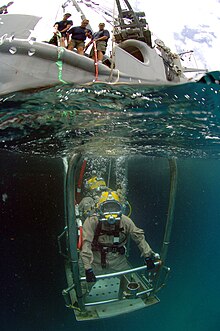 Global Information
Global InformationUnderwater diving information

Underwater diving, as a human activity, is the practice of descending below the water's surface to interact with the environment. It is also often referred to as diving, an ambiguous term with several possible meanings, depending on context. Immersion in water and exposure to high ambient pressure have physiological effects that limit the depths and duration possible in ambient pressure diving. Humans are not physiologically and anatomically well-adapted to the environmental conditions of diving, and various equipment has been developed to extend the depth and duration of human dives, and allow different types of work to be done.
In ambient pressure diving, the diver is directly exposed to the pressure of the surrounding water. The ambient pressure diver may dive on breath-hold (freediving) or use breathing apparatus for scuba diving or surface-supplied diving, and the saturation diving technique reduces the risk of decompression sickness (DCS) after long-duration deep dives. Atmospheric diving suits (ADS) may be used to isolate the diver from high ambient pressure. Crewed submersibles can extend depth range to full ocean depth, and remotely controlled or robotic machines can reduce risk to humans.
The environment exposes the diver to a wide range of hazards, and though the risks are largely controlled by appropriate diving skills, training, types of equipment and breathing gases used depending on the mode, depth and purpose of diving, it remains a relatively dangerous activity. Professional diving is usually regulated by occupational health and safety legislation, while recreational diving may be entirely unregulated. Diving activities are restricted to maximum depths of about 40 metres (130 ft) for recreational scuba diving, 530 metres (1,740 ft) for commercial saturation diving, and 610 metres (2,000 ft) wearing atmospheric suits. Diving is also restricted to conditions which are not excessively hazardous, though the level of risk acceptable can vary, and fatal incidents may occur.
Recreational diving (sometimes called sport diving or subaquatics) is a popular leisure activity. Technical diving is a form of recreational diving under more challenging conditions. Professional diving (commercial diving, diving for research purposes, or for financial gain) involves working underwater. Public safety diving is the underwater work done by law enforcement, fire rescue, and underwater search and recovery dive teams. Military diving includes combat diving, clearance diving and ships husbandry. Deep sea diving is underwater diving, usually with surface-supplied equipment, and often refers to the use of standard diving dress with the traditional copper helmet. Hard hat diving is any form of diving with a helmet, including the standard copper helmet, and other forms of free-flow and lightweight demand helmets. The history of breath-hold diving goes back at least to classical times, and there is evidence of prehistoric hunting and gathering of seafoods that may have involved underwater swimming. Technical advances allowing the provision of breathing gas to a diver underwater at ambient pressure are recent, and self-contained breathing systems developed at an accelerated rate following the Second World War.